ENG219 Argumentative Essay: Ethics and Necessity of Animal Testing
VerifiedAdded on 2023/05/30
|9
|2454
|300
Essay
AI Summary
This argumentative essay delves into the complex issue of testing products on animals, exploring its benefits and inevitability in ensuring human safety. It begins by referencing historical medical advancements made through animal experimentation, such as Dr. Jenner's work on vaccinations. The essay addresses concerns raised by animal rights advocates while emphasizing the ethical considerations scientists adhere to, including the principles of reduction, refinement, and replacement (3Rs). It presents evidence from various scholars, highlighting the lack of viable alternatives for certain critical tests and the positive outcomes achieved through animal testing, particularly in developing treatments for diseases like AIDS and malaria. The essay also notes advancements in technology, such as the use of humanized rodents and in vitro cell cultures, which aim to minimize animal harm. The essay concludes by acknowledging the ongoing efforts to find alternatives to animal testing while reaffirming its current necessity in safeguarding human health, inviting readers to explore similar essays and study resources on Desklib.
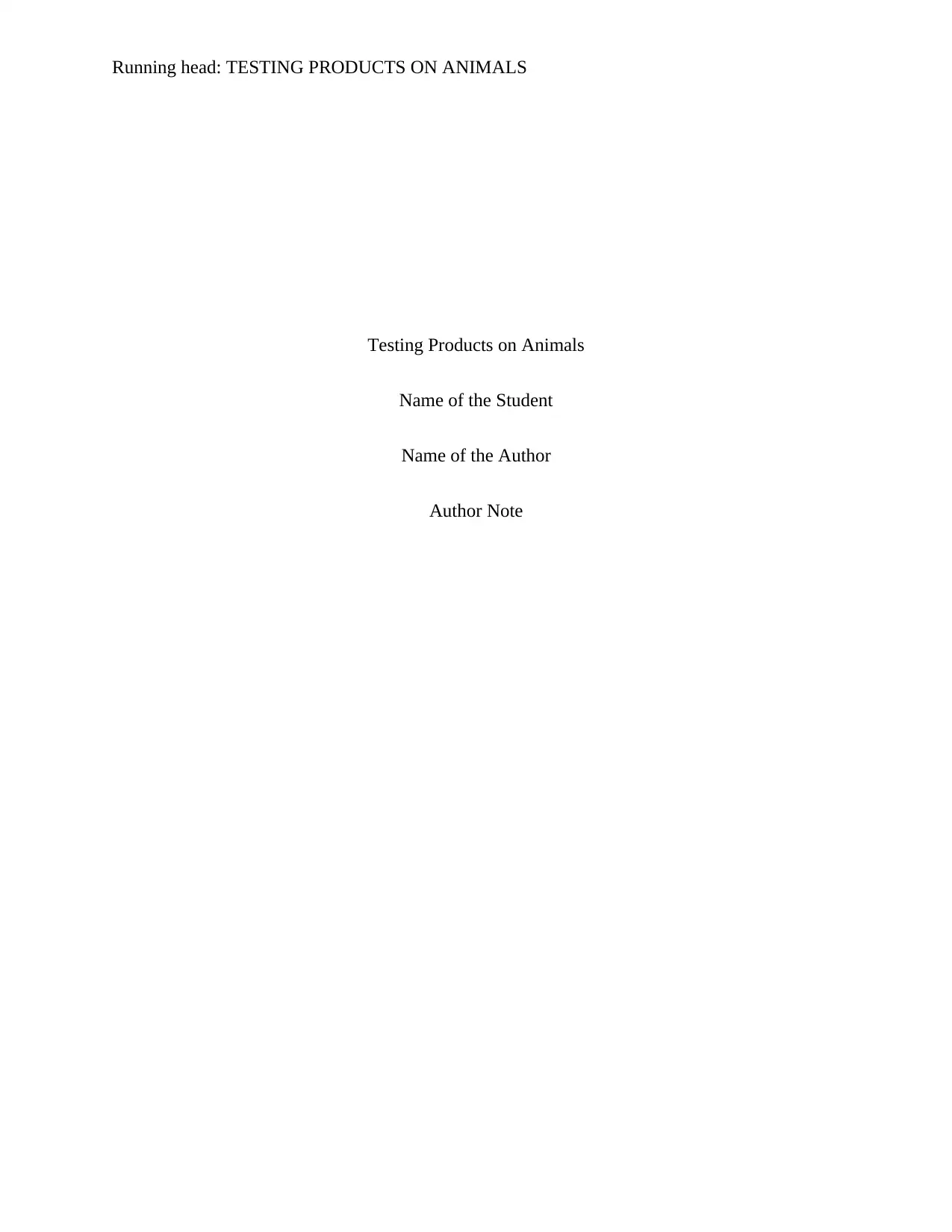
Running head: TESTING PRODUCTS ON ANIMALS
Testing Products on Animals
Name of the Student
Name of the Author
Author Note
Testing Products on Animals
Name of the Student
Name of the Author
Author Note
Paraphrase This Document
Need a fresh take? Get an instant paraphrase of this document with our AI Paraphraser
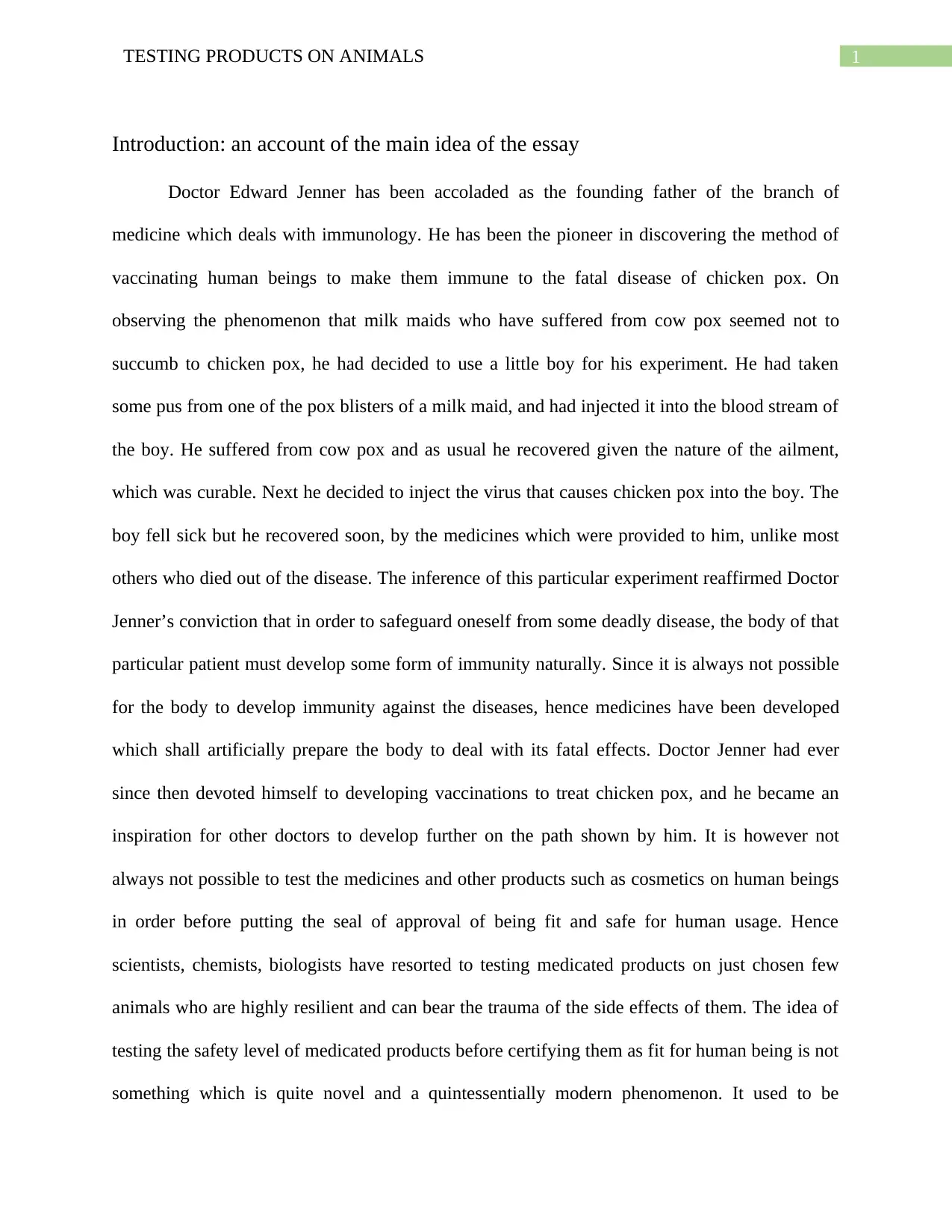
1TESTING PRODUCTS ON ANIMALS
Introduction: an account of the main idea of the essay
Doctor Edward Jenner has been accoladed as the founding father of the branch of
medicine which deals with immunology. He has been the pioneer in discovering the method of
vaccinating human beings to make them immune to the fatal disease of chicken pox. On
observing the phenomenon that milk maids who have suffered from cow pox seemed not to
succumb to chicken pox, he had decided to use a little boy for his experiment. He had taken
some pus from one of the pox blisters of a milk maid, and had injected it into the blood stream of
the boy. He suffered from cow pox and as usual he recovered given the nature of the ailment,
which was curable. Next he decided to inject the virus that causes chicken pox into the boy. The
boy fell sick but he recovered soon, by the medicines which were provided to him, unlike most
others who died out of the disease. The inference of this particular experiment reaffirmed Doctor
Jenner’s conviction that in order to safeguard oneself from some deadly disease, the body of that
particular patient must develop some form of immunity naturally. Since it is always not possible
for the body to develop immunity against the diseases, hence medicines have been developed
which shall artificially prepare the body to deal with its fatal effects. Doctor Jenner had ever
since then devoted himself to developing vaccinations to treat chicken pox, and he became an
inspiration for other doctors to develop further on the path shown by him. It is however not
always not possible to test the medicines and other products such as cosmetics on human beings
in order before putting the seal of approval of being fit and safe for human usage. Hence
scientists, chemists, biologists have resorted to testing medicated products on just chosen few
animals who are highly resilient and can bear the trauma of the side effects of them. The idea of
testing the safety level of medicated products before certifying them as fit for human being is not
something which is quite novel and a quintessentially modern phenomenon. It used to be
Introduction: an account of the main idea of the essay
Doctor Edward Jenner has been accoladed as the founding father of the branch of
medicine which deals with immunology. He has been the pioneer in discovering the method of
vaccinating human beings to make them immune to the fatal disease of chicken pox. On
observing the phenomenon that milk maids who have suffered from cow pox seemed not to
succumb to chicken pox, he had decided to use a little boy for his experiment. He had taken
some pus from one of the pox blisters of a milk maid, and had injected it into the blood stream of
the boy. He suffered from cow pox and as usual he recovered given the nature of the ailment,
which was curable. Next he decided to inject the virus that causes chicken pox into the boy. The
boy fell sick but he recovered soon, by the medicines which were provided to him, unlike most
others who died out of the disease. The inference of this particular experiment reaffirmed Doctor
Jenner’s conviction that in order to safeguard oneself from some deadly disease, the body of that
particular patient must develop some form of immunity naturally. Since it is always not possible
for the body to develop immunity against the diseases, hence medicines have been developed
which shall artificially prepare the body to deal with its fatal effects. Doctor Jenner had ever
since then devoted himself to developing vaccinations to treat chicken pox, and he became an
inspiration for other doctors to develop further on the path shown by him. It is however not
always not possible to test the medicines and other products such as cosmetics on human beings
in order before putting the seal of approval of being fit and safe for human usage. Hence
scientists, chemists, biologists have resorted to testing medicated products on just chosen few
animals who are highly resilient and can bear the trauma of the side effects of them. The idea of
testing the safety level of medicated products before certifying them as fit for human being is not
something which is quite novel and a quintessentially modern phenomenon. It used to be
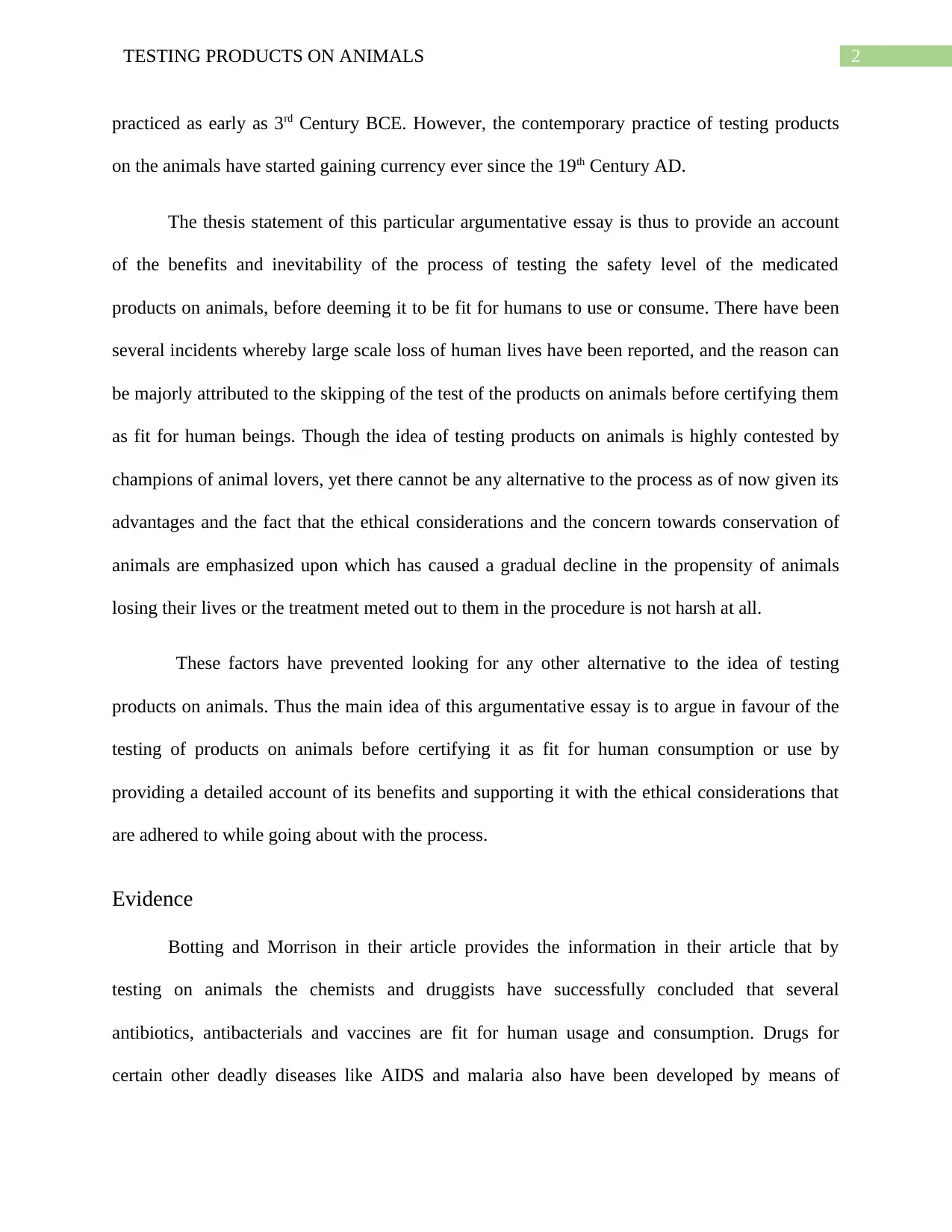
2TESTING PRODUCTS ON ANIMALS
practiced as early as 3rd Century BCE. However, the contemporary practice of testing products
on the animals have started gaining currency ever since the 19th Century AD.
The thesis statement of this particular argumentative essay is thus to provide an account
of the benefits and inevitability of the process of testing the safety level of the medicated
products on animals, before deeming it to be fit for humans to use or consume. There have been
several incidents whereby large scale loss of human lives have been reported, and the reason can
be majorly attributed to the skipping of the test of the products on animals before certifying them
as fit for human beings. Though the idea of testing products on animals is highly contested by
champions of animal lovers, yet there cannot be any alternative to the process as of now given its
advantages and the fact that the ethical considerations and the concern towards conservation of
animals are emphasized upon which has caused a gradual decline in the propensity of animals
losing their lives or the treatment meted out to them in the procedure is not harsh at all.
These factors have prevented looking for any other alternative to the idea of testing
products on animals. Thus the main idea of this argumentative essay is to argue in favour of the
testing of products on animals before certifying it as fit for human consumption or use by
providing a detailed account of its benefits and supporting it with the ethical considerations that
are adhered to while going about with the process.
Evidence
Botting and Morrison in their article provides the information in their article that by
testing on animals the chemists and druggists have successfully concluded that several
antibiotics, antibacterials and vaccines are fit for human usage and consumption. Drugs for
certain other deadly diseases like AIDS and malaria also have been developed by means of
practiced as early as 3rd Century BCE. However, the contemporary practice of testing products
on the animals have started gaining currency ever since the 19th Century AD.
The thesis statement of this particular argumentative essay is thus to provide an account
of the benefits and inevitability of the process of testing the safety level of the medicated
products on animals, before deeming it to be fit for humans to use or consume. There have been
several incidents whereby large scale loss of human lives have been reported, and the reason can
be majorly attributed to the skipping of the test of the products on animals before certifying them
as fit for human beings. Though the idea of testing products on animals is highly contested by
champions of animal lovers, yet there cannot be any alternative to the process as of now given its
advantages and the fact that the ethical considerations and the concern towards conservation of
animals are emphasized upon which has caused a gradual decline in the propensity of animals
losing their lives or the treatment meted out to them in the procedure is not harsh at all.
These factors have prevented looking for any other alternative to the idea of testing
products on animals. Thus the main idea of this argumentative essay is to argue in favour of the
testing of products on animals before certifying it as fit for human consumption or use by
providing a detailed account of its benefits and supporting it with the ethical considerations that
are adhered to while going about with the process.
Evidence
Botting and Morrison in their article provides the information in their article that by
testing on animals the chemists and druggists have successfully concluded that several
antibiotics, antibacterials and vaccines are fit for human usage and consumption. Drugs for
certain other deadly diseases like AIDS and malaria also have been developed by means of
⊘ This is a preview!⊘
Do you want full access?
Subscribe today to unlock all pages.

Trusted by 1+ million students worldwide
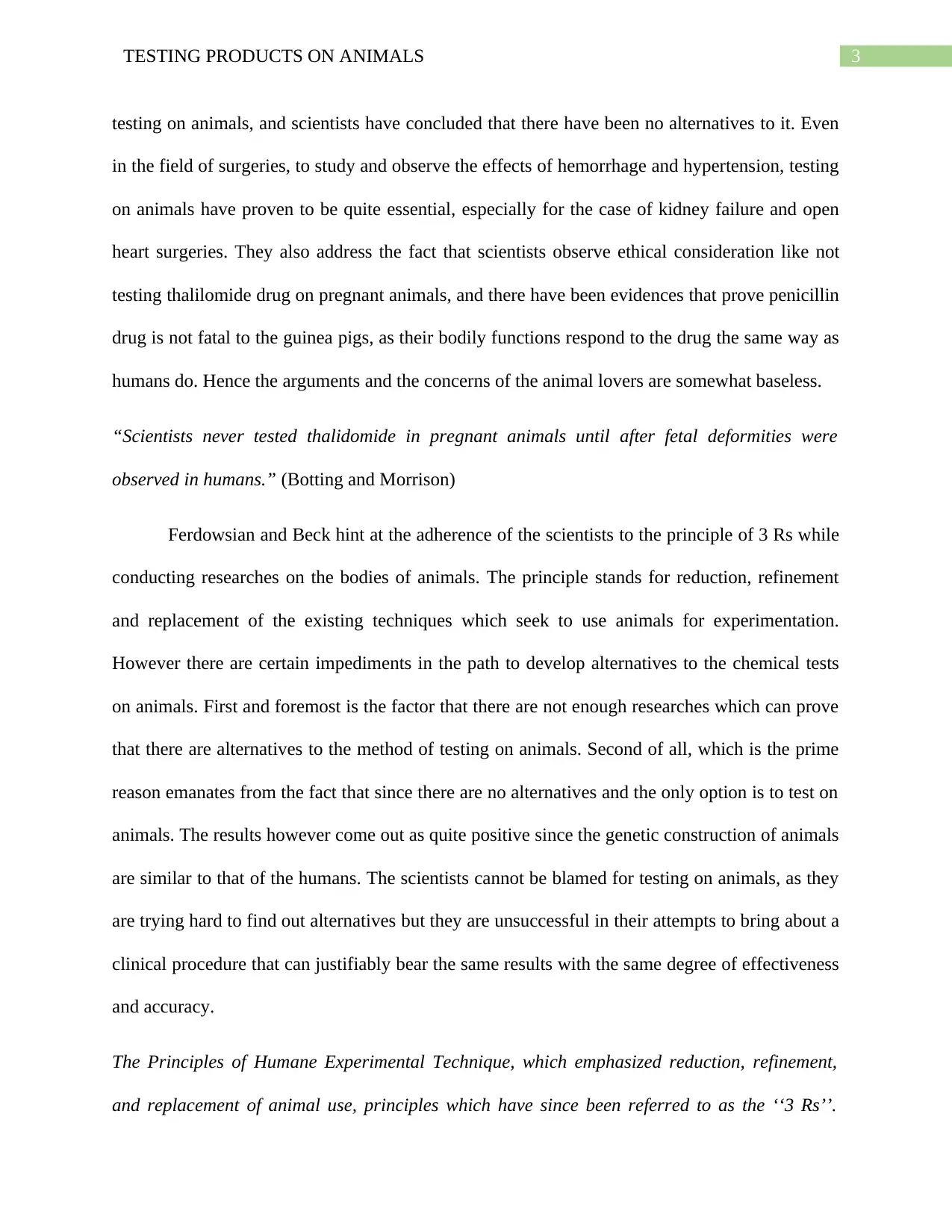
3TESTING PRODUCTS ON ANIMALS
testing on animals, and scientists have concluded that there have been no alternatives to it. Even
in the field of surgeries, to study and observe the effects of hemorrhage and hypertension, testing
on animals have proven to be quite essential, especially for the case of kidney failure and open
heart surgeries. They also address the fact that scientists observe ethical consideration like not
testing thalilomide drug on pregnant animals, and there have been evidences that prove penicillin
drug is not fatal to the guinea pigs, as their bodily functions respond to the drug the same way as
humans do. Hence the arguments and the concerns of the animal lovers are somewhat baseless.
“Scientists never tested thalidomide in pregnant animals until after fetal deformities were
observed in humans.” (Botting and Morrison)
Ferdowsian and Beck hint at the adherence of the scientists to the principle of 3 Rs while
conducting researches on the bodies of animals. The principle stands for reduction, refinement
and replacement of the existing techniques which seek to use animals for experimentation.
However there are certain impediments in the path to develop alternatives to the chemical tests
on animals. First and foremost is the factor that there are not enough researches which can prove
that there are alternatives to the method of testing on animals. Second of all, which is the prime
reason emanates from the fact that since there are no alternatives and the only option is to test on
animals. The results however come out as quite positive since the genetic construction of animals
are similar to that of the humans. The scientists cannot be blamed for testing on animals, as they
are trying hard to find out alternatives but they are unsuccessful in their attempts to bring about a
clinical procedure that can justifiably bear the same results with the same degree of effectiveness
and accuracy.
The Principles of Humane Experimental Technique, which emphasized reduction, refinement,
and replacement of animal use, principles which have since been referred to as the ‘‘3 Rs’’.
testing on animals, and scientists have concluded that there have been no alternatives to it. Even
in the field of surgeries, to study and observe the effects of hemorrhage and hypertension, testing
on animals have proven to be quite essential, especially for the case of kidney failure and open
heart surgeries. They also address the fact that scientists observe ethical consideration like not
testing thalilomide drug on pregnant animals, and there have been evidences that prove penicillin
drug is not fatal to the guinea pigs, as their bodily functions respond to the drug the same way as
humans do. Hence the arguments and the concerns of the animal lovers are somewhat baseless.
“Scientists never tested thalidomide in pregnant animals until after fetal deformities were
observed in humans.” (Botting and Morrison)
Ferdowsian and Beck hint at the adherence of the scientists to the principle of 3 Rs while
conducting researches on the bodies of animals. The principle stands for reduction, refinement
and replacement of the existing techniques which seek to use animals for experimentation.
However there are certain impediments in the path to develop alternatives to the chemical tests
on animals. First and foremost is the factor that there are not enough researches which can prove
that there are alternatives to the method of testing on animals. Second of all, which is the prime
reason emanates from the fact that since there are no alternatives and the only option is to test on
animals. The results however come out as quite positive since the genetic construction of animals
are similar to that of the humans. The scientists cannot be blamed for testing on animals, as they
are trying hard to find out alternatives but they are unsuccessful in their attempts to bring about a
clinical procedure that can justifiably bear the same results with the same degree of effectiveness
and accuracy.
The Principles of Humane Experimental Technique, which emphasized reduction, refinement,
and replacement of animal use, principles which have since been referred to as the ‘‘3 Rs’’.
Paraphrase This Document
Need a fresh take? Get an instant paraphrase of this document with our AI Paraphraser
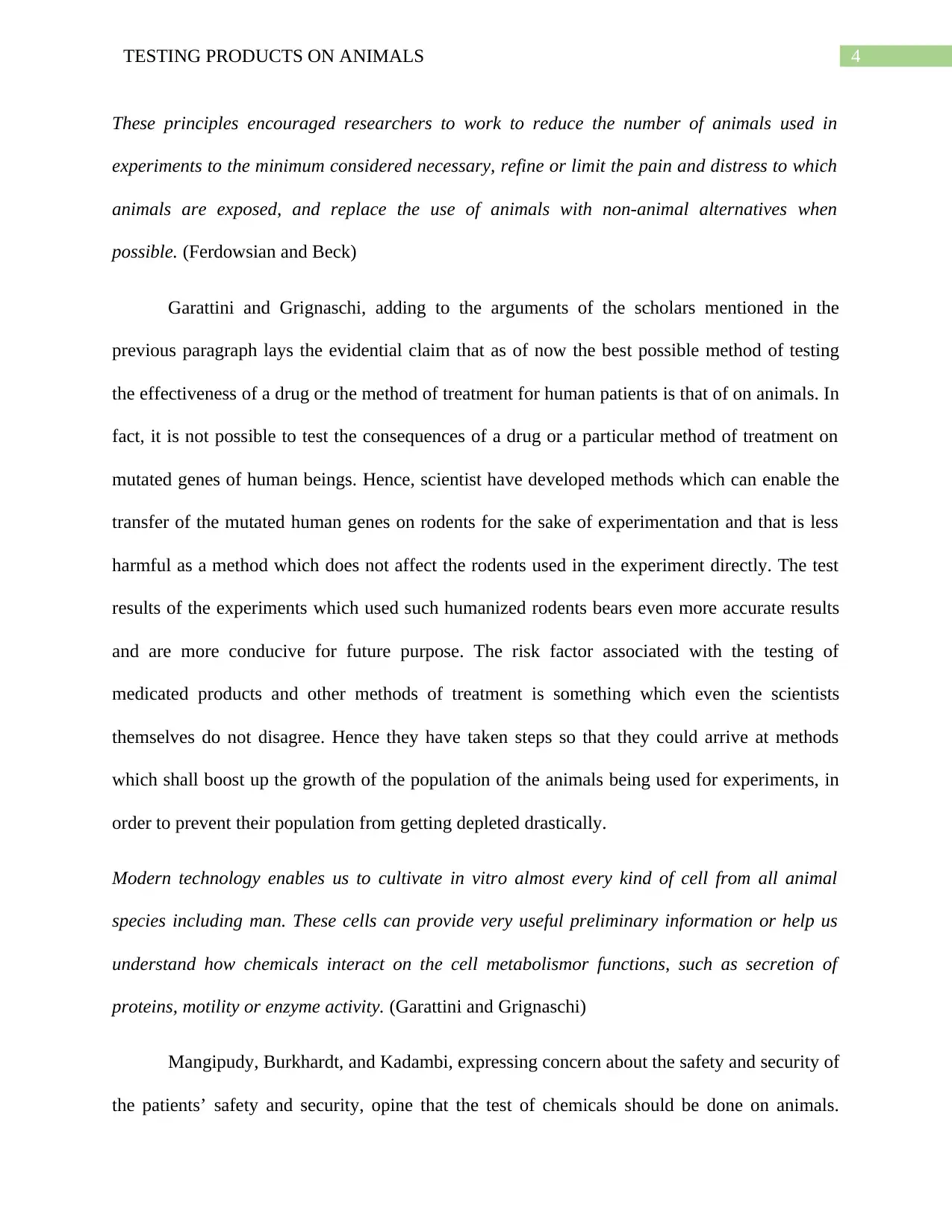
4TESTING PRODUCTS ON ANIMALS
These principles encouraged researchers to work to reduce the number of animals used in
experiments to the minimum considered necessary, refine or limit the pain and distress to which
animals are exposed, and replace the use of animals with non-animal alternatives when
possible. (Ferdowsian and Beck)
Garattini and Grignaschi, adding to the arguments of the scholars mentioned in the
previous paragraph lays the evidential claim that as of now the best possible method of testing
the effectiveness of a drug or the method of treatment for human patients is that of on animals. In
fact, it is not possible to test the consequences of a drug or a particular method of treatment on
mutated genes of human beings. Hence, scientist have developed methods which can enable the
transfer of the mutated human genes on rodents for the sake of experimentation and that is less
harmful as a method which does not affect the rodents used in the experiment directly. The test
results of the experiments which used such humanized rodents bears even more accurate results
and are more conducive for future purpose. The risk factor associated with the testing of
medicated products and other methods of treatment is something which even the scientists
themselves do not disagree. Hence they have taken steps so that they could arrive at methods
which shall boost up the growth of the population of the animals being used for experiments, in
order to prevent their population from getting depleted drastically.
Modern technology enables us to cultivate in vitro almost every kind of cell from all animal
species including man. These cells can provide very useful preliminary information or help us
understand how chemicals interact on the cell metabolismor functions, such as secretion of
proteins, motility or enzyme activity. (Garattini and Grignaschi)
Mangipudy, Burkhardt, and Kadambi, expressing concern about the safety and security of
the patients’ safety and security, opine that the test of chemicals should be done on animals.
These principles encouraged researchers to work to reduce the number of animals used in
experiments to the minimum considered necessary, refine or limit the pain and distress to which
animals are exposed, and replace the use of animals with non-animal alternatives when
possible. (Ferdowsian and Beck)
Garattini and Grignaschi, adding to the arguments of the scholars mentioned in the
previous paragraph lays the evidential claim that as of now the best possible method of testing
the effectiveness of a drug or the method of treatment for human patients is that of on animals. In
fact, it is not possible to test the consequences of a drug or a particular method of treatment on
mutated genes of human beings. Hence, scientist have developed methods which can enable the
transfer of the mutated human genes on rodents for the sake of experimentation and that is less
harmful as a method which does not affect the rodents used in the experiment directly. The test
results of the experiments which used such humanized rodents bears even more accurate results
and are more conducive for future purpose. The risk factor associated with the testing of
medicated products and other methods of treatment is something which even the scientists
themselves do not disagree. Hence they have taken steps so that they could arrive at methods
which shall boost up the growth of the population of the animals being used for experiments, in
order to prevent their population from getting depleted drastically.
Modern technology enables us to cultivate in vitro almost every kind of cell from all animal
species including man. These cells can provide very useful preliminary information or help us
understand how chemicals interact on the cell metabolismor functions, such as secretion of
proteins, motility or enzyme activity. (Garattini and Grignaschi)
Mangipudy, Burkhardt, and Kadambi, expressing concern about the safety and security of
the patients’ safety and security, opine that the test of chemicals should be done on animals.
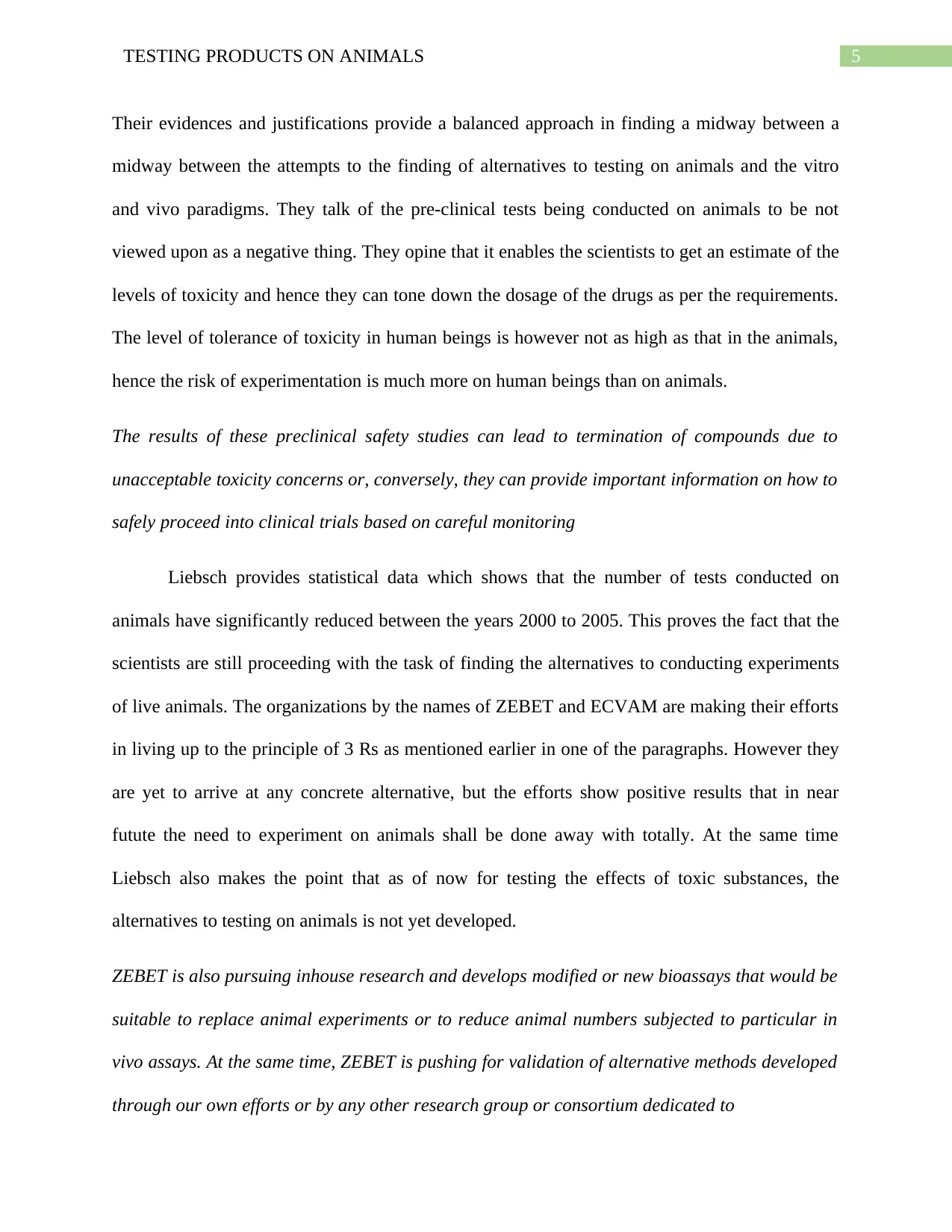
5TESTING PRODUCTS ON ANIMALS
Their evidences and justifications provide a balanced approach in finding a midway between a
midway between the attempts to the finding of alternatives to testing on animals and the vitro
and vivo paradigms. They talk of the pre-clinical tests being conducted on animals to be not
viewed upon as a negative thing. They opine that it enables the scientists to get an estimate of the
levels of toxicity and hence they can tone down the dosage of the drugs as per the requirements.
The level of tolerance of toxicity in human beings is however not as high as that in the animals,
hence the risk of experimentation is much more on human beings than on animals.
The results of these preclinical safety studies can lead to termination of compounds due to
unacceptable toxicity concerns or, conversely, they can provide important information on how to
safely proceed into clinical trials based on careful monitoring
Liebsch provides statistical data which shows that the number of tests conducted on
animals have significantly reduced between the years 2000 to 2005. This proves the fact that the
scientists are still proceeding with the task of finding the alternatives to conducting experiments
of live animals. The organizations by the names of ZEBET and ECVAM are making their efforts
in living up to the principle of 3 Rs as mentioned earlier in one of the paragraphs. However they
are yet to arrive at any concrete alternative, but the efforts show positive results that in near
futute the need to experiment on animals shall be done away with totally. At the same time
Liebsch also makes the point that as of now for testing the effects of toxic substances, the
alternatives to testing on animals is not yet developed.
ZEBET is also pursuing inhouse research and develops modified or new bioassays that would be
suitable to replace animal experiments or to reduce animal numbers subjected to particular in
vivo assays. At the same time, ZEBET is pushing for validation of alternative methods developed
through our own efforts or by any other research group or consortium dedicated to
Their evidences and justifications provide a balanced approach in finding a midway between a
midway between the attempts to the finding of alternatives to testing on animals and the vitro
and vivo paradigms. They talk of the pre-clinical tests being conducted on animals to be not
viewed upon as a negative thing. They opine that it enables the scientists to get an estimate of the
levels of toxicity and hence they can tone down the dosage of the drugs as per the requirements.
The level of tolerance of toxicity in human beings is however not as high as that in the animals,
hence the risk of experimentation is much more on human beings than on animals.
The results of these preclinical safety studies can lead to termination of compounds due to
unacceptable toxicity concerns or, conversely, they can provide important information on how to
safely proceed into clinical trials based on careful monitoring
Liebsch provides statistical data which shows that the number of tests conducted on
animals have significantly reduced between the years 2000 to 2005. This proves the fact that the
scientists are still proceeding with the task of finding the alternatives to conducting experiments
of live animals. The organizations by the names of ZEBET and ECVAM are making their efforts
in living up to the principle of 3 Rs as mentioned earlier in one of the paragraphs. However they
are yet to arrive at any concrete alternative, but the efforts show positive results that in near
futute the need to experiment on animals shall be done away with totally. At the same time
Liebsch also makes the point that as of now for testing the effects of toxic substances, the
alternatives to testing on animals is not yet developed.
ZEBET is also pursuing inhouse research and develops modified or new bioassays that would be
suitable to replace animal experiments or to reduce animal numbers subjected to particular in
vivo assays. At the same time, ZEBET is pushing for validation of alternative methods developed
through our own efforts or by any other research group or consortium dedicated to
⊘ This is a preview!⊘
Do you want full access?
Subscribe today to unlock all pages.

Trusted by 1+ million students worldwide
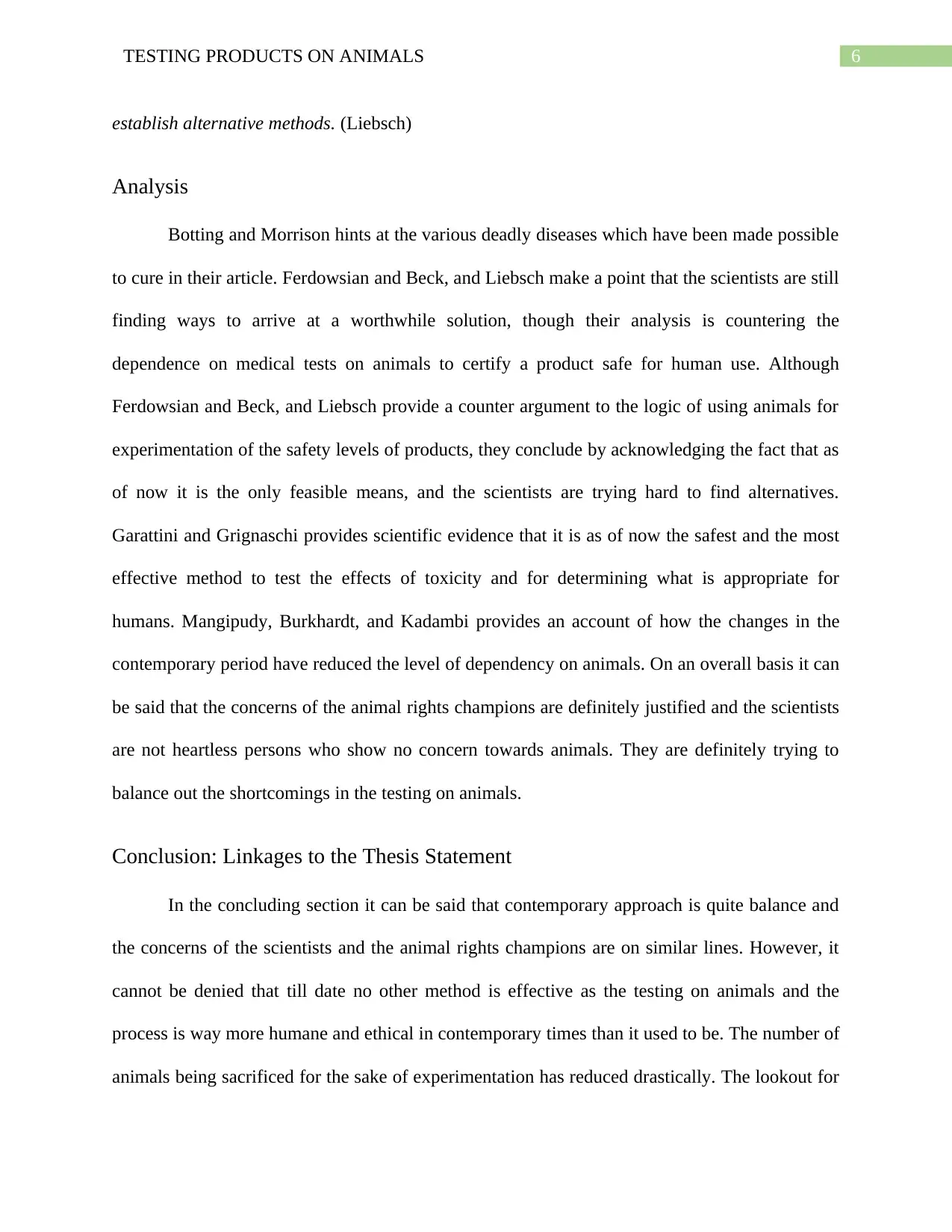
6TESTING PRODUCTS ON ANIMALS
establish alternative methods. (Liebsch)
Analysis
Botting and Morrison hints at the various deadly diseases which have been made possible
to cure in their article. Ferdowsian and Beck, and Liebsch make a point that the scientists are still
finding ways to arrive at a worthwhile solution, though their analysis is countering the
dependence on medical tests on animals to certify a product safe for human use. Although
Ferdowsian and Beck, and Liebsch provide a counter argument to the logic of using animals for
experimentation of the safety levels of products, they conclude by acknowledging the fact that as
of now it is the only feasible means, and the scientists are trying hard to find alternatives.
Garattini and Grignaschi provides scientific evidence that it is as of now the safest and the most
effective method to test the effects of toxicity and for determining what is appropriate for
humans. Mangipudy, Burkhardt, and Kadambi provides an account of how the changes in the
contemporary period have reduced the level of dependency on animals. On an overall basis it can
be said that the concerns of the animal rights champions are definitely justified and the scientists
are not heartless persons who show no concern towards animals. They are definitely trying to
balance out the shortcomings in the testing on animals.
Conclusion: Linkages to the Thesis Statement
In the concluding section it can be said that contemporary approach is quite balance and
the concerns of the scientists and the animal rights champions are on similar lines. However, it
cannot be denied that till date no other method is effective as the testing on animals and the
process is way more humane and ethical in contemporary times than it used to be. The number of
animals being sacrificed for the sake of experimentation has reduced drastically. The lookout for
establish alternative methods. (Liebsch)
Analysis
Botting and Morrison hints at the various deadly diseases which have been made possible
to cure in their article. Ferdowsian and Beck, and Liebsch make a point that the scientists are still
finding ways to arrive at a worthwhile solution, though their analysis is countering the
dependence on medical tests on animals to certify a product safe for human use. Although
Ferdowsian and Beck, and Liebsch provide a counter argument to the logic of using animals for
experimentation of the safety levels of products, they conclude by acknowledging the fact that as
of now it is the only feasible means, and the scientists are trying hard to find alternatives.
Garattini and Grignaschi provides scientific evidence that it is as of now the safest and the most
effective method to test the effects of toxicity and for determining what is appropriate for
humans. Mangipudy, Burkhardt, and Kadambi provides an account of how the changes in the
contemporary period have reduced the level of dependency on animals. On an overall basis it can
be said that the concerns of the animal rights champions are definitely justified and the scientists
are not heartless persons who show no concern towards animals. They are definitely trying to
balance out the shortcomings in the testing on animals.
Conclusion: Linkages to the Thesis Statement
In the concluding section it can be said that contemporary approach is quite balance and
the concerns of the scientists and the animal rights champions are on similar lines. However, it
cannot be denied that till date no other method is effective as the testing on animals and the
process is way more humane and ethical in contemporary times than it used to be. The number of
animals being sacrificed for the sake of experimentation has reduced drastically. The lookout for
Paraphrase This Document
Need a fresh take? Get an instant paraphrase of this document with our AI Paraphraser
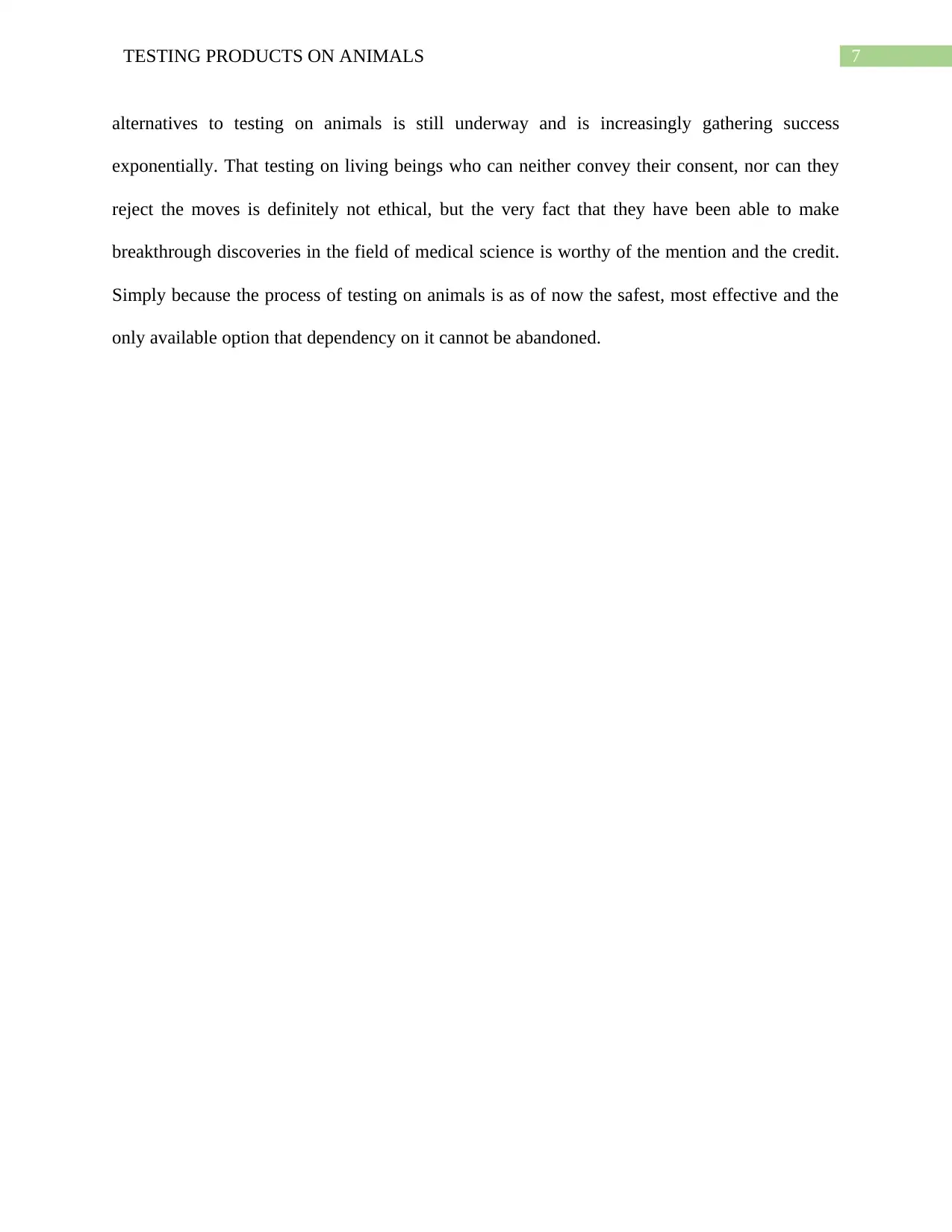
7TESTING PRODUCTS ON ANIMALS
alternatives to testing on animals is still underway and is increasingly gathering success
exponentially. That testing on living beings who can neither convey their consent, nor can they
reject the moves is definitely not ethical, but the very fact that they have been able to make
breakthrough discoveries in the field of medical science is worthy of the mention and the credit.
Simply because the process of testing on animals is as of now the safest, most effective and the
only available option that dependency on it cannot be abandoned.
alternatives to testing on animals is still underway and is increasingly gathering success
exponentially. That testing on living beings who can neither convey their consent, nor can they
reject the moves is definitely not ethical, but the very fact that they have been able to make
breakthrough discoveries in the field of medical science is worthy of the mention and the credit.
Simply because the process of testing on animals is as of now the safest, most effective and the
only available option that dependency on it cannot be abandoned.
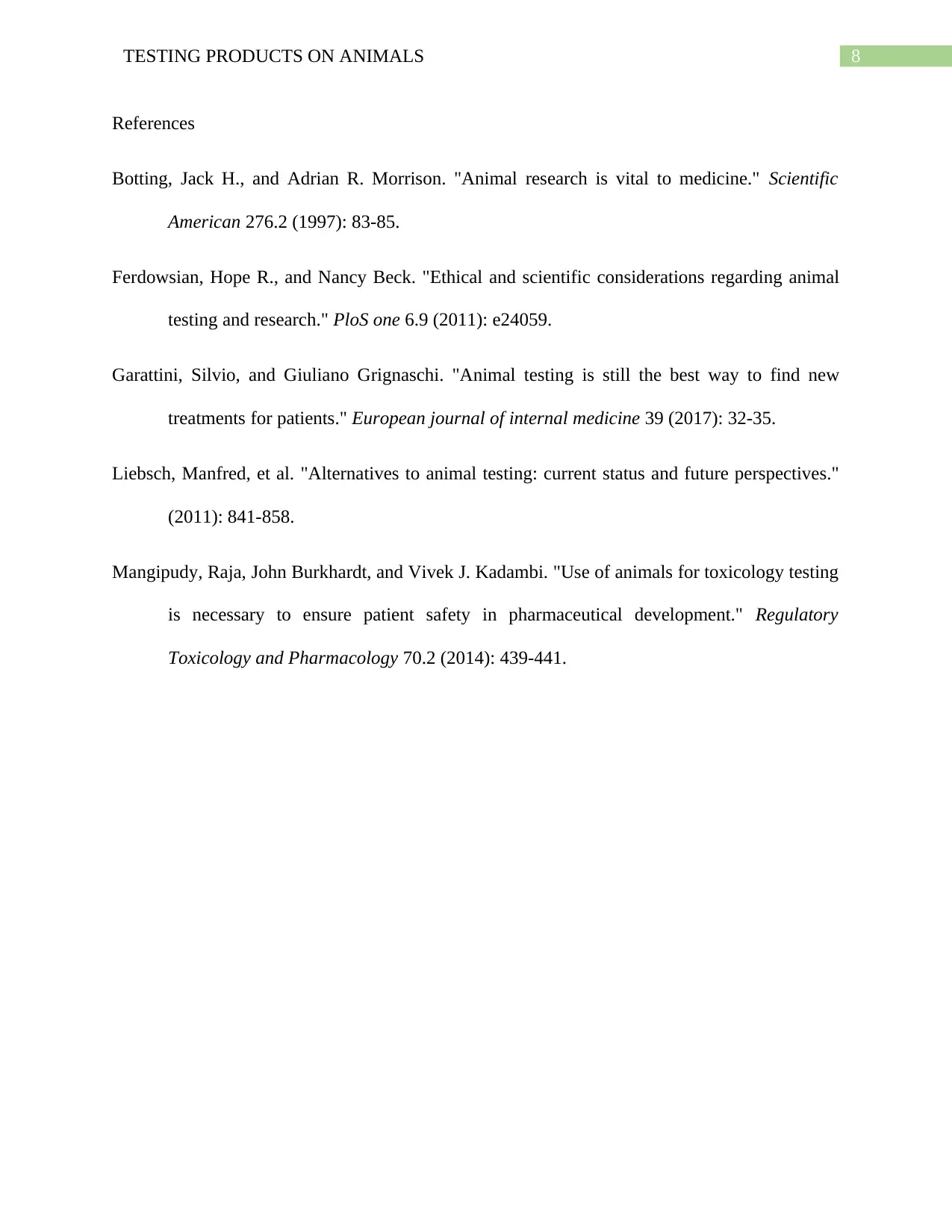
8TESTING PRODUCTS ON ANIMALS
References
Botting, Jack H., and Adrian R. Morrison. "Animal research is vital to medicine." Scientific
American 276.2 (1997): 83-85.
Ferdowsian, Hope R., and Nancy Beck. "Ethical and scientific considerations regarding animal
testing and research." PloS one 6.9 (2011): e24059.
Garattini, Silvio, and Giuliano Grignaschi. "Animal testing is still the best way to find new
treatments for patients." European journal of internal medicine 39 (2017): 32-35.
Liebsch, Manfred, et al. "Alternatives to animal testing: current status and future perspectives."
(2011): 841-858.
Mangipudy, Raja, John Burkhardt, and Vivek J. Kadambi. "Use of animals for toxicology testing
is necessary to ensure patient safety in pharmaceutical development." Regulatory
Toxicology and Pharmacology 70.2 (2014): 439-441.
References
Botting, Jack H., and Adrian R. Morrison. "Animal research is vital to medicine." Scientific
American 276.2 (1997): 83-85.
Ferdowsian, Hope R., and Nancy Beck. "Ethical and scientific considerations regarding animal
testing and research." PloS one 6.9 (2011): e24059.
Garattini, Silvio, and Giuliano Grignaschi. "Animal testing is still the best way to find new
treatments for patients." European journal of internal medicine 39 (2017): 32-35.
Liebsch, Manfred, et al. "Alternatives to animal testing: current status and future perspectives."
(2011): 841-858.
Mangipudy, Raja, John Burkhardt, and Vivek J. Kadambi. "Use of animals for toxicology testing
is necessary to ensure patient safety in pharmaceutical development." Regulatory
Toxicology and Pharmacology 70.2 (2014): 439-441.
⊘ This is a preview!⊘
Do you want full access?
Subscribe today to unlock all pages.

Trusted by 1+ million students worldwide
1 out of 9
Your All-in-One AI-Powered Toolkit for Academic Success.
+13062052269
info@desklib.com
Available 24*7 on WhatsApp / Email
![[object Object]](/_next/static/media/star-bottom.7253800d.svg)
Unlock your academic potential
Copyright © 2020–2025 A2Z Services. All Rights Reserved. Developed and managed by ZUCOL.